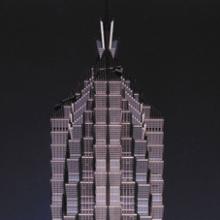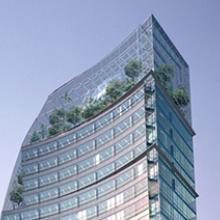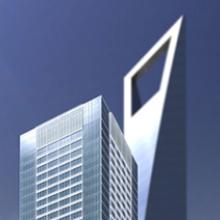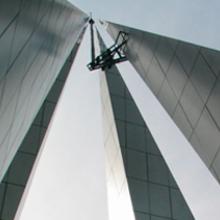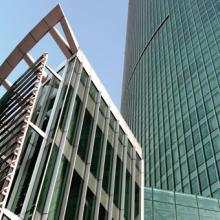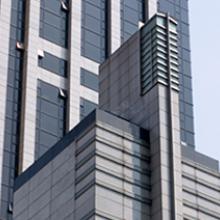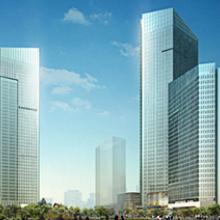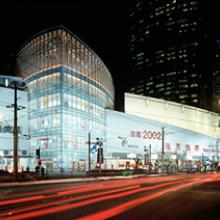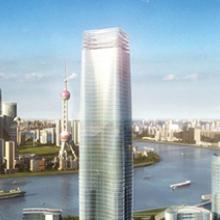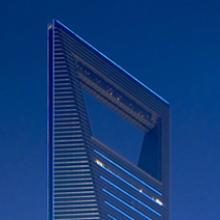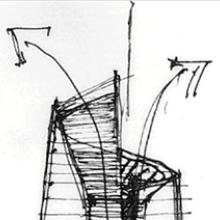International Terminal
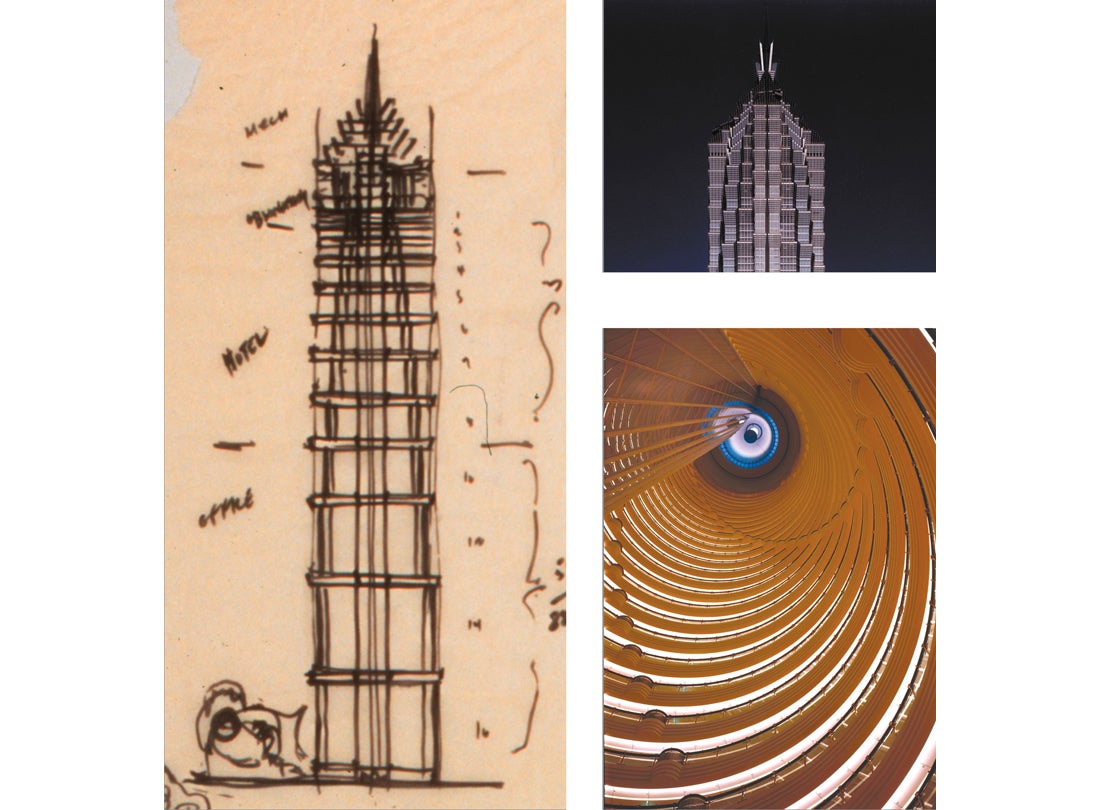
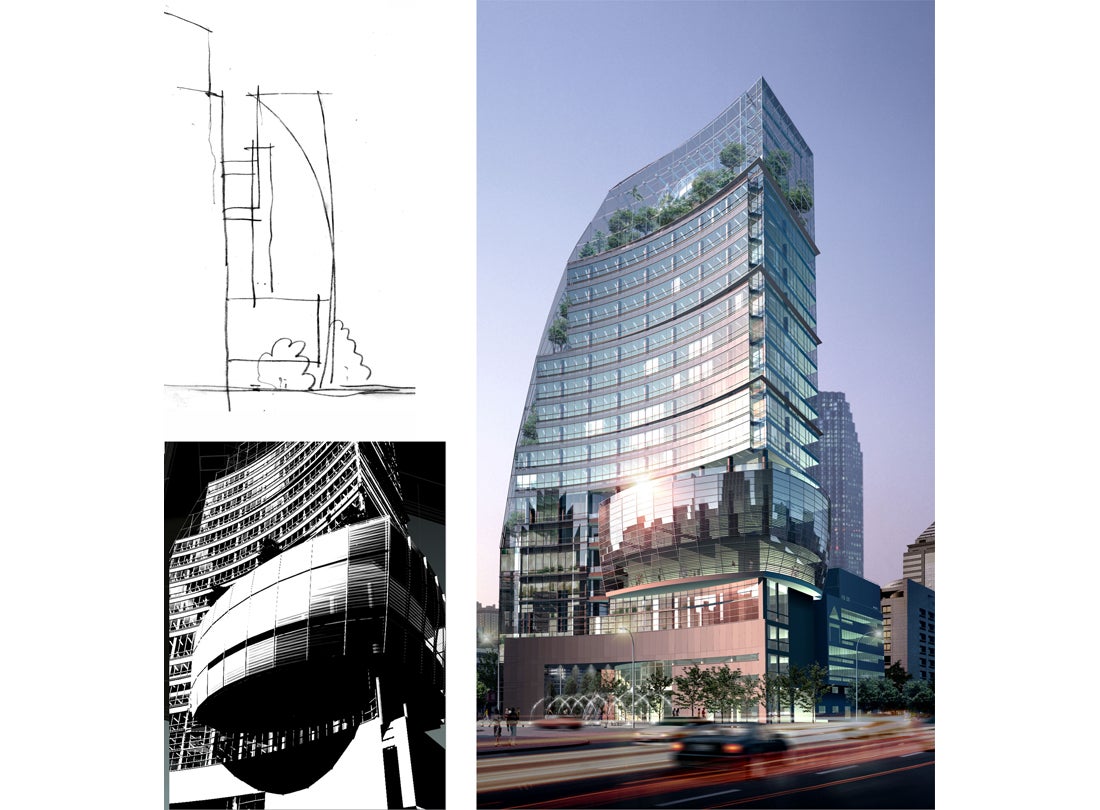
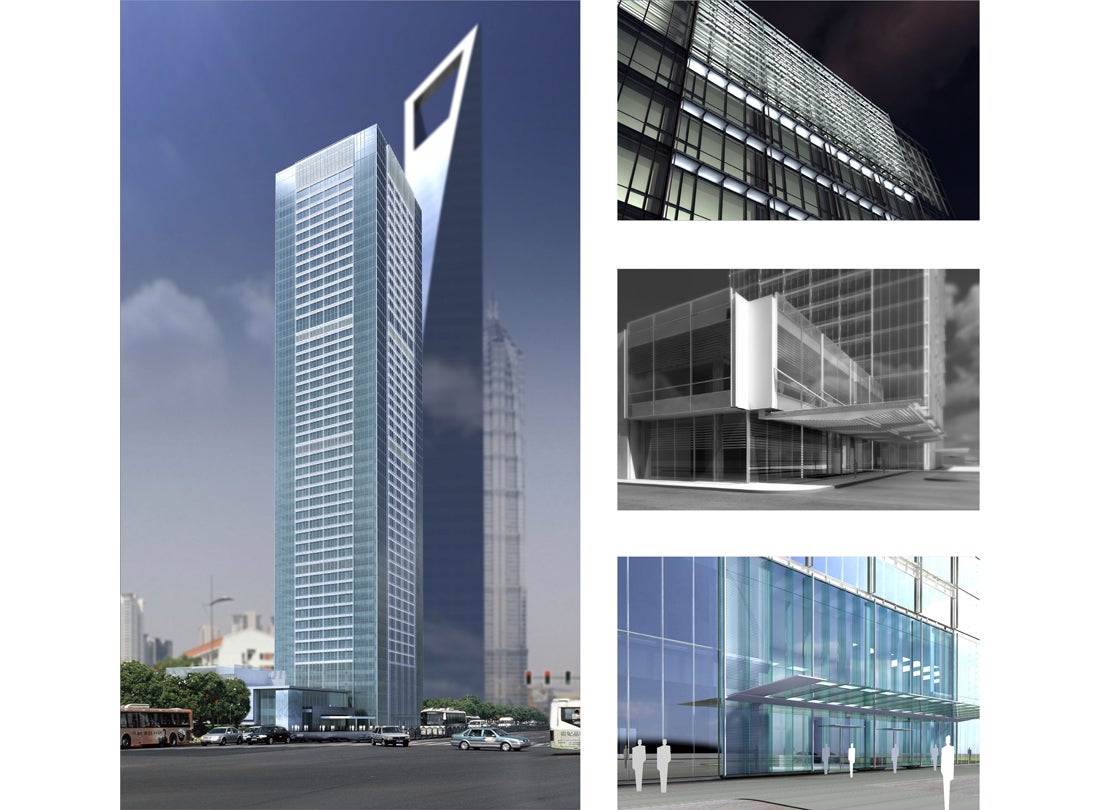
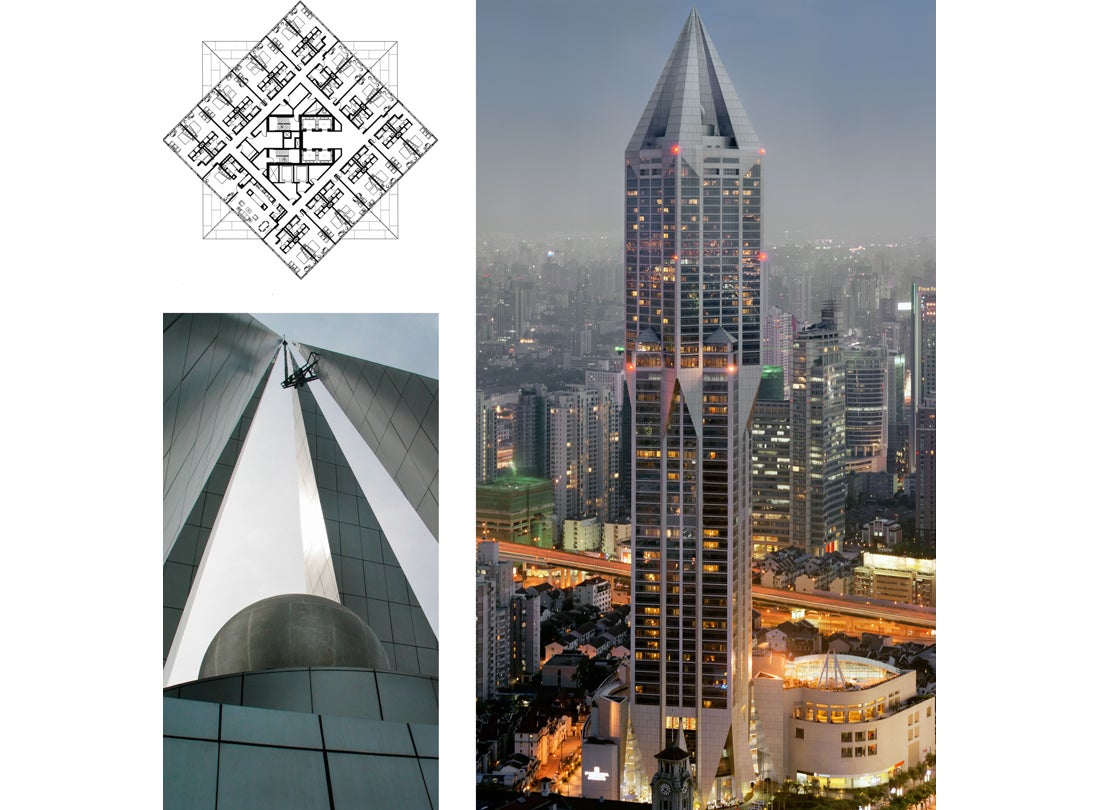
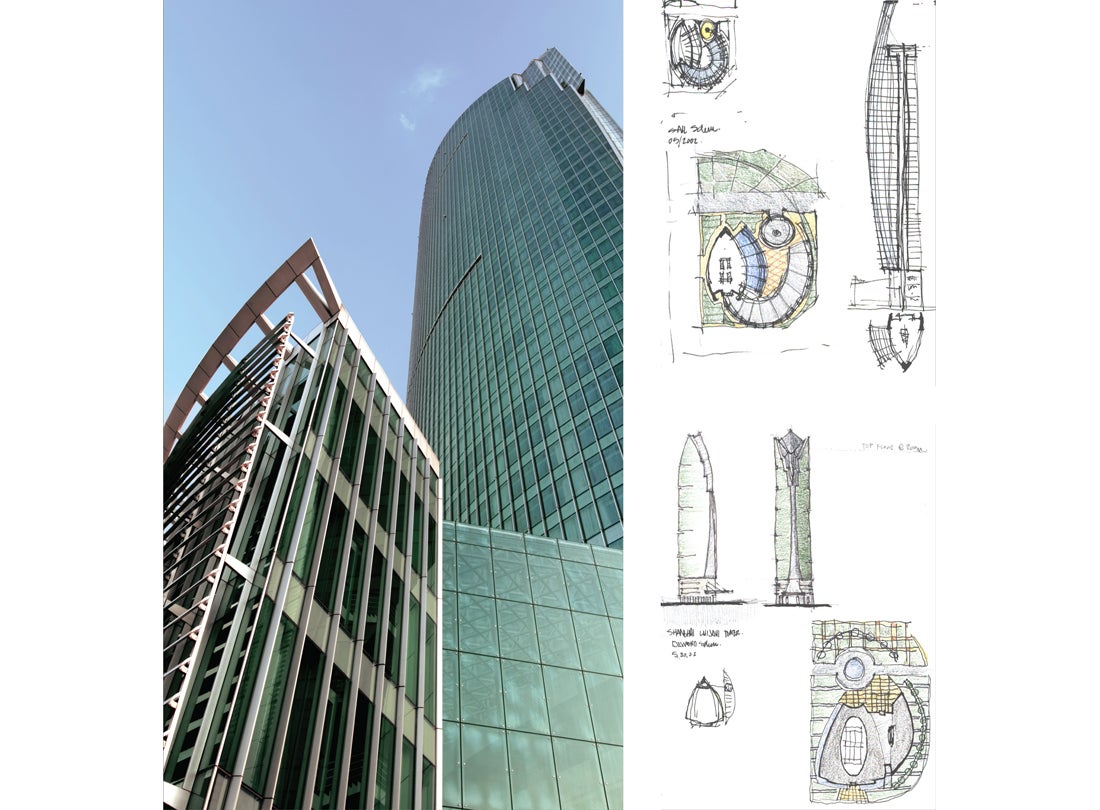
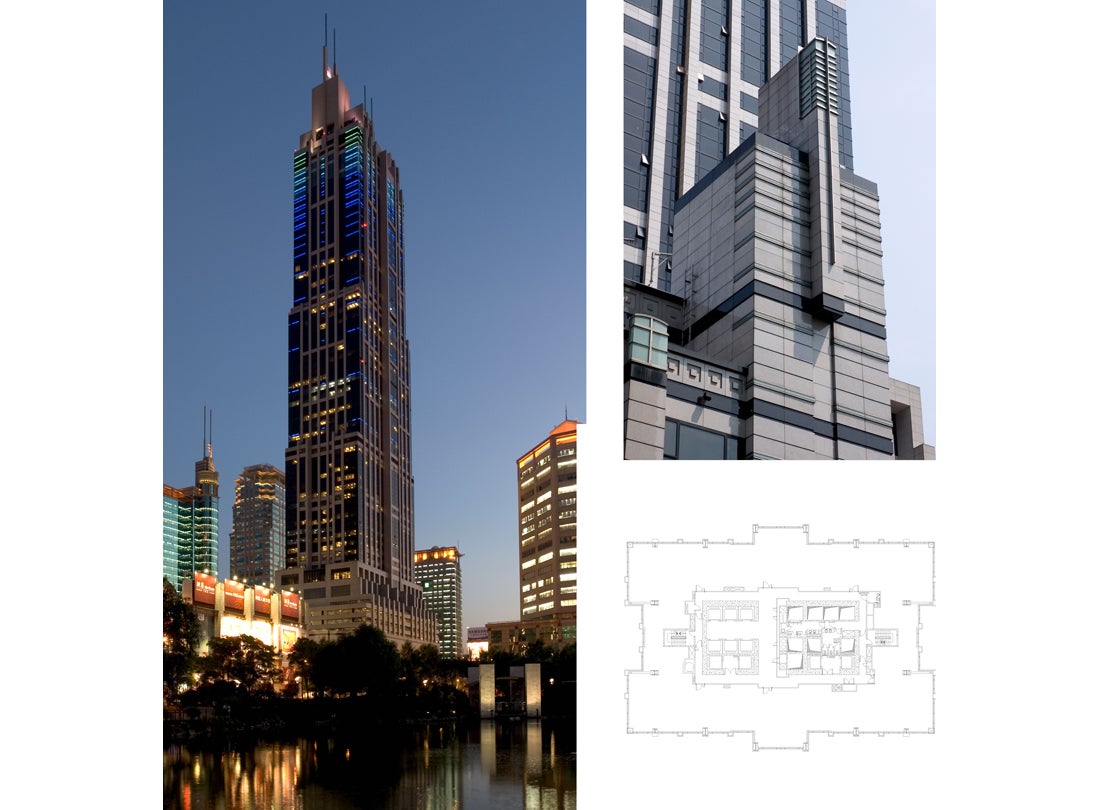
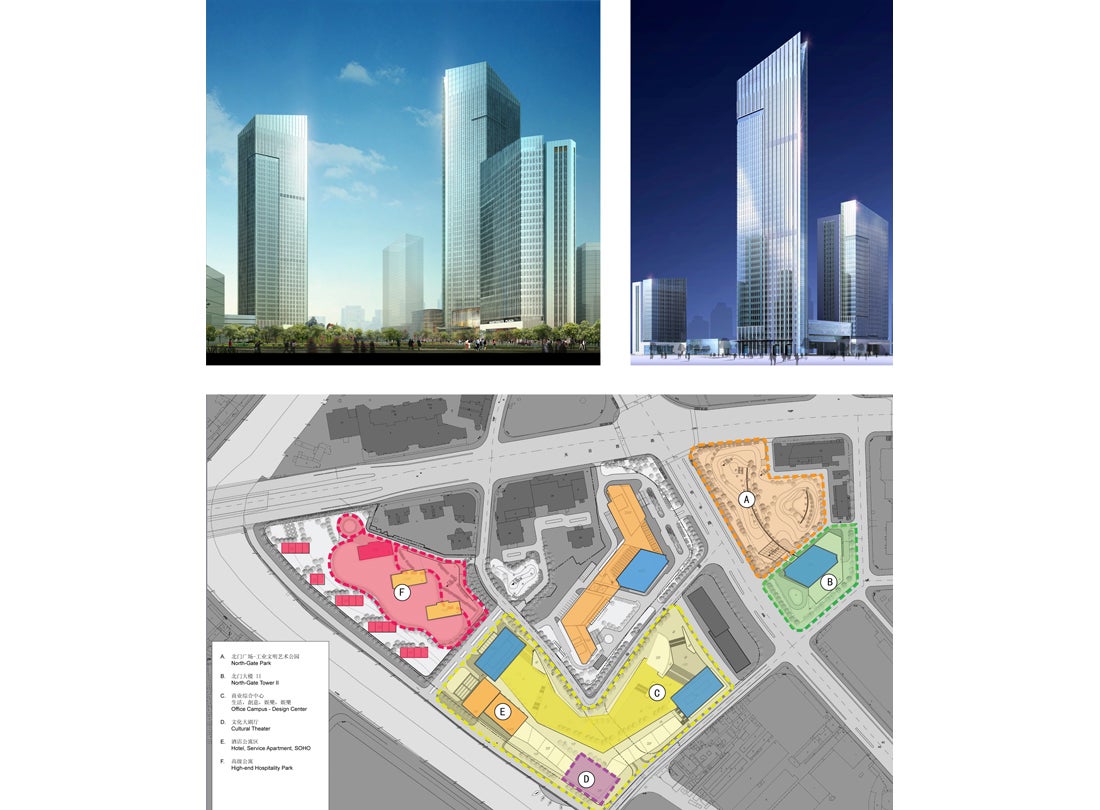
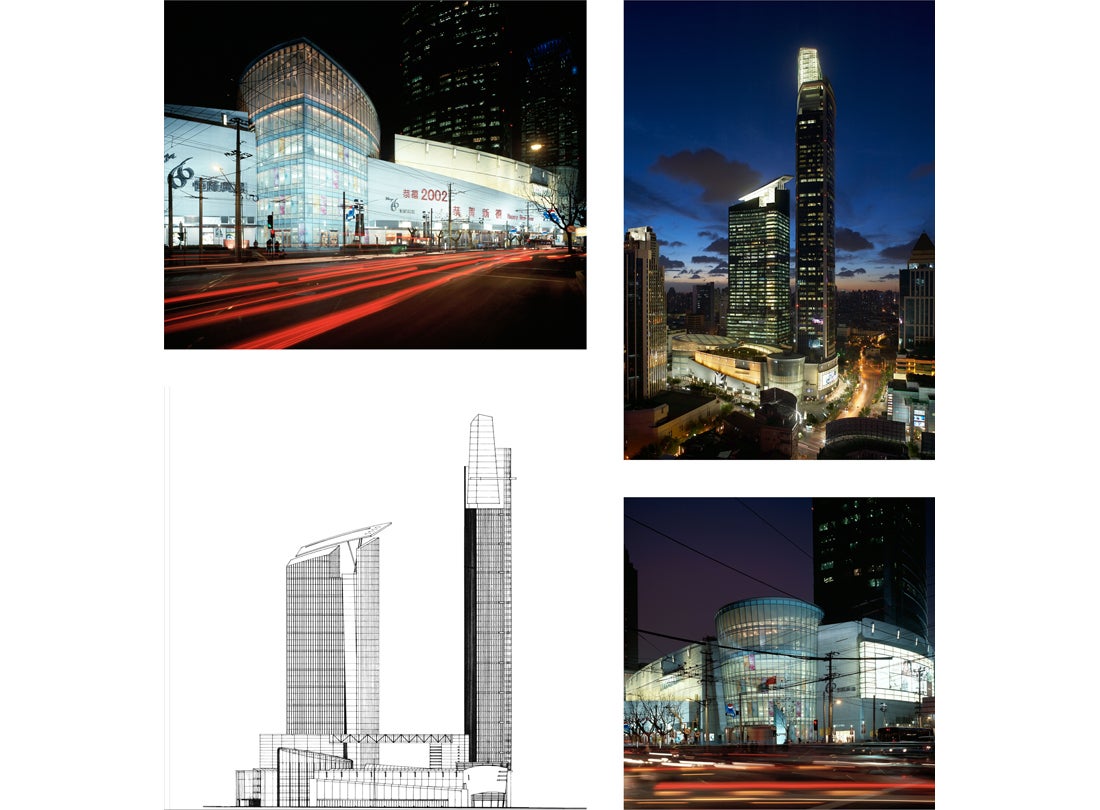
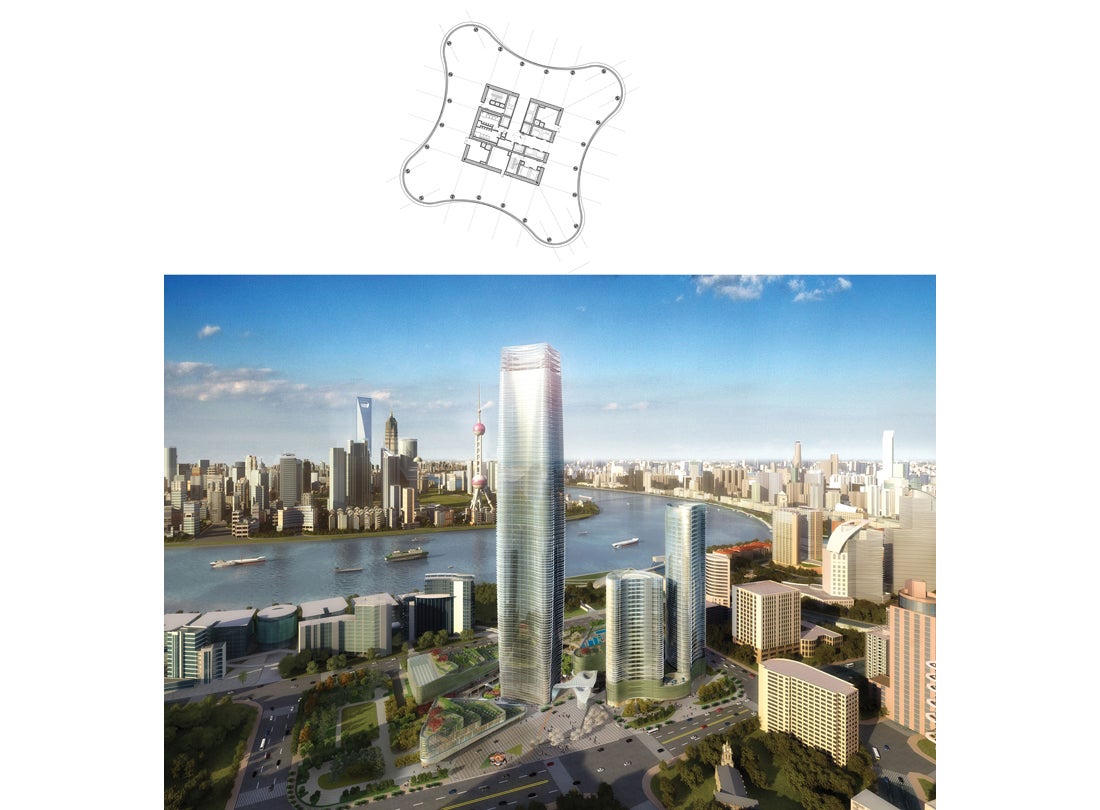
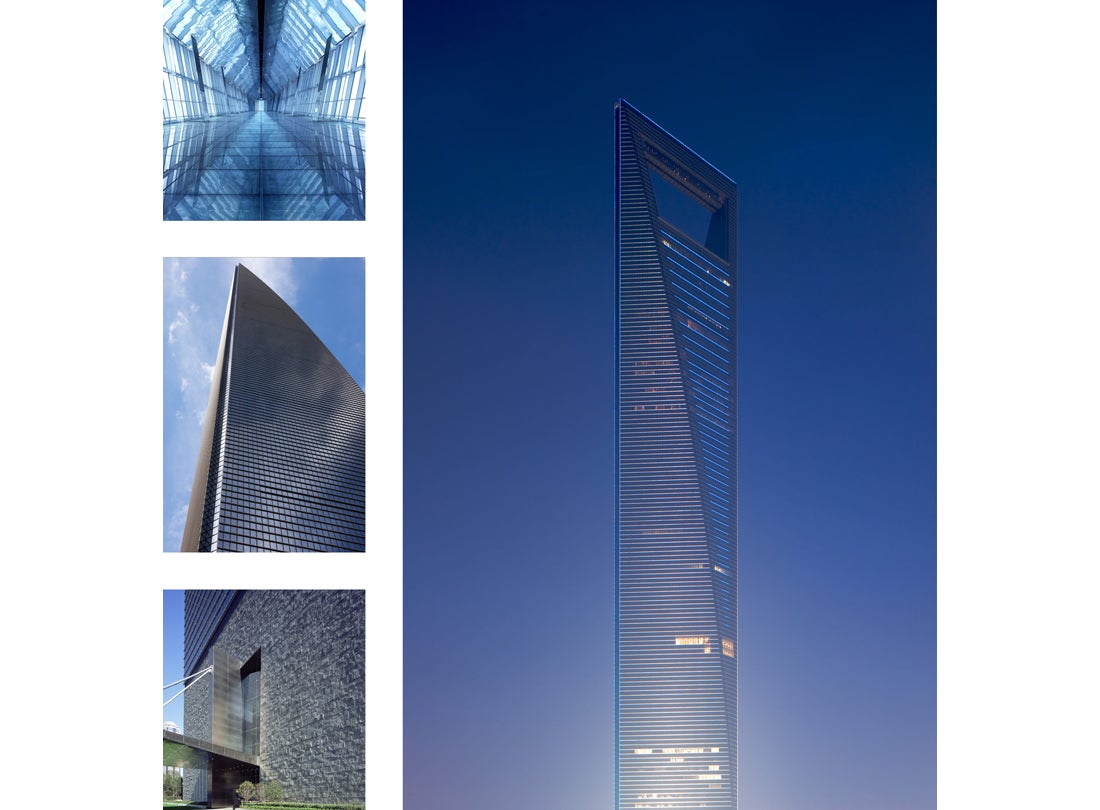
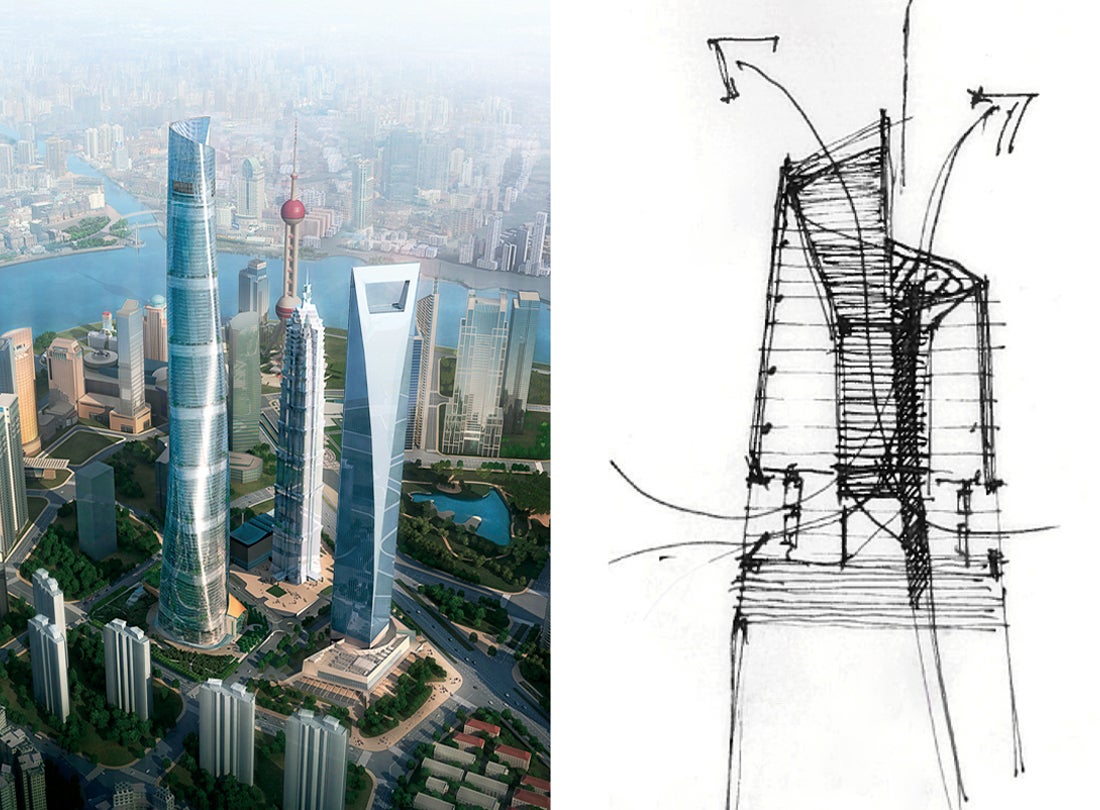
Jin Mao Tower sketches
© Skidmore, Owings & Merrill LLP, 2010. All rights reserved.
R2009.3406.004
Jin Mao Tower detail
© Skidmore, Owings & Merrill LLP, 2010. All rights reserved.
R2009.3406.006
Jin Mao Tower atrium interior
© Skidmore, Owings & Merrill LLP, 2010. All rights reserved.
R2009.3406.007
Jin Mao Tower 1994–99
Lujiazui Financial District, Pudong, Shanghai, China
Skidmore, Owings & Merrill LLP (SOM)
Primary offices involved: Chicago and Shanghai
Height at top of spire: 1,381 feet/421 meters
Height at top of roof: 1,214 feet/370 meters
Stories: 88
Area: 3,096,852 square feet/287,707 square meters
Facility: office, hotel, observation, retail
SOM's Jin Mao Tower, which translates as "Golden Prosperity Building," was the first of the three main buildings at the center of Shanghai's master plan for redevelopment. The building's tiered, pagoda-like form is intended to symbolize China's past, while its octagonal floor plan and eighty-eight stories evoke the symbolically prosperous number eight in Chinese culture. Jin Mao Tower was the tallest building in China at the time of its completion and remains one of its most iconic. With office space in the lower fifty stories and a luxury hotel in the top thirty-eight, Jin Mao Tower has set a high standard for mixed-use programming.
Jie Fang Daily News Headquarters sketch
Courtesy of KMD Architects
R2009.3404.003
Jie Fang Daily News Headquarters perspective
Courtesy of KMD Architects
R2009.3404.004
Jie Fang Daily News Headquarters facade detail
Courtesy of KMD Architects
R2009.3404.005
Jie Fang Daily News Headquarters 2004–08
Huangpu District, Puxi, Shanghai, China
KMD Architects
Primary office involved: San Francisco
Height at top of roof: 292 feet/89 meters
Stories: 19
Area: 187,000 square feet/17,372 square meters
Facility: office, two-hole golf course
San Francisco-based KMD Architects, an early advocate of sustainable design practices, produced the Jie Fang Daily News Headquarters to accommodate the company's fast-growing East China Division. The building's main feature is a seventeen-story atrium filled with bamboo, indigenous trees, and gardens that collectively serve as a central "lung" to cleanse the building's air. The building's passive exhaust system expels air through operable fins on the structure's facade. The translucent facility creates more natural, day-lit spaces for worker interaction and has received the highest possible LEED (Leadership in Energy and Environmental Design) rating—the suite of standards established by the United States Green Building Council.
21st Century Tower perspective
Courtesy of Gensler
R2009.3407.052
21st Century Tower facade detail rendering
Courtesy of Gensler
R2009.3407.053
21st Century Tower podium rendering
Courtesy of Gensler
R2009.3407.054
21st Century Tower lobby facade rendering
Courtesy of Gensler
R2009.3407.055
21st Century Tower
Lujiazui Financial District, Pudong, Shanghai, China
Gensler
Primary offices involved: San Francisco and Shanghai
Height at top of spire: 692 feet/211 meters
Height at top of roof: 656 feet/200 meters
Stories: 50
Area: 895,000 square feet/83,148 square meters
Facility: office, hotel, luxury condominiums
Construction had already begun on a previous design when the Gensler design team was contracted to "start all over" on 21st Century Tower. The building's foundations and three levels of underground parking had been constructed, and Shanghai officials had already approved a massing for the tower of a very simple rectangular volume that could not be changed. In a city of architectural show-offs, the given, simple mass was embraced by the architects as an opportunity to create a tall, slender, and elegant counterpoint to the exuberant forms of its neighbors. The building's sustainable features include an energy-saving enclosure of high-performance insulated glass, exhaust air scrubbers, waste interceptors, reduced exterior light pollution, significant use of local materials including glass, stone, and recycled construction waste materials.
Tomorrow Square level 40 hotel floor plan
Courtesy of John Portman & Associates
R2009.3403.003
Tomorrow Square at dusk
Photography: Michael Portman
Courtesy of John Portman & Associates
R2009.3403.004
Tomorrow Square tower termination (detail)
Courtesy of John Portman & Associates
R2009.3403.005
Tomorrow Square 1997–2003
Huangpu District, Puxi, Shanghai, China
John Portman & Associates
Primary offices involved: Atlanta and Shanghai
Height at top of spire: 938 feet/286 meters
Height at top of roof: 781 feet/238 meters
Stories: 60
Area: 1,002,000 square feet/93,000 square meters
Facility: hotel, serviced apartments, retail, restaurant
Tomorrow Square is an iconic presence in the geographic center of Shanghai. The building was designed by Atlanta-based John Portman & Associates, one of the first foreign architectural firms working in China after relations with the United States were officially normalized in 1979. Tomorrow Square includes three major elements on a landscaped plaza—a high-rise tower, a low-rise podium, and an atrium linking the two. Halfway up the facade, the building's basic square plan is rotated by forty-five degrees to indicate a change in its function from residential apartments to a hotel. Tomorrow Square's distinctive pinnacle is formed by four corners that rise toward each other but never meet, symbolizing the city's upward reach and boundless potential.
Zhongrong Jasper Tower facade detail
Photography: Blain Crellin Photography
Courtesy of Gresham, Smith and Partners
R2009.3405.003
Zhongrong Jasper Tower concept sketches
Courtesy of Gresham, Smith and Partners
R2009.3405.002, .004
Zhongrong Jasper Tower 2005–08
Lujiazui Financial District, Pudong, Shanghai, China
Gresham, Smith and Partners
Primary offices involved: Nashville, Tennessee; Richmond, Virginia; and Shanghai
Height at top of spire: 705 feet/215 meters
Height at top of roof: 656 feet/200 meters
Stories: 45
Area: 800,000 square feet/74,322 square meters
Facility: office, hotel, residential
Gresham, Smith and Partner's jewel-like building takes its name from its resemblance to a diamond embedded in jasper. The building's curved triangular form and the angle of its placement allow two-thirds of the inhabitants a view of the Huangpu River. Most of the heat-resistant curtain wall is green reflective glass with butt-glazed horizontal joints and expressed mullions (dividing structural elements) that give the tower a vertical emphasis. The top and front side of the building's skin is a tension-assisted glass wall system composed of clear glass. Separating the mass of the office tower and podium building is a four-story, glass-roofed atrium with cascading gardens and spectacular views of the river and city.
Hong Kong New World Tower at dusk
Photography: Kerun Ip
Courtesy of B+H Architects
R2009.3408.003
Hong Kong New World Tower detail
Photography: Kerun Ip
Courtesy of B+H Architects
R2009.3408.004
Hong Kong New World Tower typical floor plan
Courtesy of B+H Architects
R2009.3408.005
Hong Kong New World Tower 1998–2003
Luwan District, Puxi, Shanghai, China
B+H Architects
Primary offices involved: Toronto and Shanghai
Height at top of spire: 912 feet/278 meters
Height at top of roof: 794 feet/242 meters
Stories: 59
Area: 1,453,130 square feet/135,000 square meters
Facility: office, retail
Hong Kong New World Tower was designed by Toronto-based B+H Architects. The company has been active in China since 1992 and incorporates sustainable design throughout its international practice. The tower's classic and elegant configuration is intended to celebrate Shanghai's modernity while also reflecting the city's history and culture. Its appearance contrasts with the curvilinear forms and translucent facades of many of its neighboring high-rises. Located at the heart of Huai Hai Road, Shanghai's most prestigious commercial street, the building's podium was designed to make the retail function of its interior visible to pedestrians at the street level.
BM Plaza perspectives
Courtesy of Gensler
R2009.3407.056, .057
BM Plaza site plan
Courtesy of Gensler
R2009.3407.058
BM Plaza 2007–09
Zhabei District, Puxi, Shanghai, China
Gensler
Primary office involved: San Francisco
Height at top of spire: 722 feet/220 meters
Height at top of roof: 666 feet/203 meters
Stories: 50
Area: 1,979,483 square feet/183,900 square meters
Facility: office, hotel
Located in the northern part of central Shanghai adjacent to the city's old railway station, Gensler's BM Plaza marks the revitalization of what was once the city's transportation hub. BM Plaza includes a tall office tower, a medium-height hotel tower, and a lower building for office headquarters. Together, the forms and functions are intimately related to create a dynamic new silhouette in the Zhabei District skyline. Facing nearby Suzhou Creek, the towers' design draws inspiration from the historic riverboats that shipped resources throughout the city a century ago. The buildings' shape mimics that of a sail, catching and refracting sunlight. The project's designers employed sophisticated sun and shade analyses to ensure the scale and massing would not negatively impact the surrounding buildings' access to light.
Plaza 66 podium facade
Photography: H. G. Esch Photography
Courtesy of Kohn Pedersen Fox Associates (KPF)
R2009.3401.008
Plaza 66 at night
Photography: Fu Xing
Courtesy of Kohn Pedersen Fox Associates (KPF)
R2009.3401.009
Plaza 66 podium facade
Photography: H. G. Esch Photography
Courtesy of Kohn Pedersen Fox Associates (KPF)
R2009.3401.010
Plaza 66 elevation
Courtesy of Kohn Pedersen Fox Associates (KPF)
R2009.3401.004
Plaza 66 (Tower I) 1994–2001, (Tower II) 2003–06
Jing'an District, Puxi, Shanghai, China
Kohn Pedersen Fox Associates (KPF)
Primary offices involved: New York and Shanghai
Height (Tower I): 945 feet/288 meters
Height (Tower II): 748 feet/228 meters
Stories (Tower I): 66
Stories (Tower II): 48
Area (Tower I): 1,000,000 square feet/92,900 square meters
Area (Tower II): 840,000 square feet/ 78,038 square meters
Facility: office, retail, nightclub
Plaza 66, designed by KPF, includes the tallest building in Puxi and is the focal point in a neighborhood of high-rise architecture. The design for the buildings' podiums was inspired by Shanghai's traditional lilongs—socially cohesive and interactive low-rise housing blocks with irregularly placed entry gates. Masonry walls are punctuated by intermittent sections of glass, and multiple street-level entrances encourage pedestrians to enter either of the building's two major interior public spaces from Shanghai's main shopping boulevard. A collage of radial forms—lozenge, cone, almond, and arc—spiral in ascending fashion with two office towers to create a unified composition, the top of which resembles a glowing lantern or flame when illuminated.
White Magnolia Plaza office tower floor plan 2008–09
© Skidmore, Owings & Merrill LLP, 2010. All rights reserved.
R2009.3406.008
White Magnolia Plaza CAD rendering 2008–09
Crystal CG
© Skidmore, Owings & Merrill LLP, 2010. All rights reserved.
R2009.3406.005
White Magnolia Plaza 2008–12
Hongkou District, Puxi, Shanghai, China
Skidmore, Owings & Merrill LLP (SOM)
Primary offices involved: Chicago and Shanghai
Height: 1,048 feet/319 meters
Stories: 66
Area: 4,270,818 square feet/396,772 square meters
Facility: office, hotel, residential
White Magnolia Plaza, currently under construction in the historic North Bund area, is the final piece of Shanghai's Huangpu Riverfront Master Plan. The project's massing will provide a harmonious counterbalance to the high-rising Pudong area across the river. SOM's design for the project has undergone several revisions, including a plan for two large, asymmetrical towers depicted in early imagery and animation.
The current design for the complex includes a strikingly sculptural office tower, two crescent-shaped hotel towers, and a series of smaller-scale, mixed-use buildings connected to a new riverfront park. The towers' complex curved surfaces are accentuated by perforated aluminum sunshades that reduce solar heat gain during the day and light pollution at night, one of several advancements that will render the project a model of efficient and sustainable design.
SWFC's 100th-floor "Sky Walk" observation deck (interior)
Photography: Mori Building Company
Courtesy of Kohn Pedersen Fox Associates (KPF)
R2009.3401.003
SWFC facade at night
Photography: H. G. Esch Photography
Courtesy of Kohn Pedersen Fox Associates (KPF)
R2009.3401.005
SWFC podium wall with split-face granite surface
Photography: Shinkenchiku
Courtesy of Kohn Pedersen Fox Associates (KPF)
R2009.3401.006
SWFC facade detail
Photography: H. G. Esch Photography
Courtesy of Kohn Pedersen Fox Associates (KPF)
R2009.3401.007
Shanghai World Financial Center 1997–2008
Lujiazui Financial District, Pudong, Shanghai, China
Kohn Pedersen Fox Associates (KPF)
Primary offices involved: New York and Shanghai
Height at top of spire: 1622 feet/494 meters
Height at top of roof: 1599 feet/487 meters
Stories: 101
Area: 4,107,500 square feet/381,600 square meters
Facility: office, luxury hotel, retail, museum, observation
KPF's Shanghai World Financial Center (SWFC) became an instant landmark when completed in 2008 as the second of three buildings planned as the centerpiece of Shanghai's skyline. The building's tapered form and distinctive aperture evoke ancient Chinese symbols for the heavens and earth and also reduce wind pressure on the surface of the immense structure. The opening, originally designed to be round, was changed to a trapezoid after complaints that it evoked the Japanese flag. The structural engineers utilized a diagonal-braced frame with outrigger trusses coupled to the building's columns to reduce the tower's weight, thus reducing the use of materials and resulting in a more transparent structure in visual and conceptual harmony with the tower's elegant form.
CAD rendering of Shanghai Tower, Jin Mao Tower, and Shanghai World Financial Center
Courtesy of Gensler
R2009.3407.012
Sketch of crown with wind turbine function
Courtesy of Gensler
R2009.3407.049
Shanghai Tower 2008–14
Lujiazui Financial District, Pudong, Shanghai, China
Gensler
Primary offices involved: San Francisco and Shanghai
Height at top of crown: 2,073 feet/632 meters
Height at top of roof: 1,903 feet/580 meters
Stories: 121
Area: 6,179,324 square feet/574,058 square meters
Facility: office, luxury hotel, entertainment, retail and cultural venues, observation
Gensler's Shanghai Tower is the final project of a harmonious trio of buildings that will provide Shanghai with its defining silhouette and stand as the centerpiece of the largest group of super high-rises in the world. More than 2,000 feet above the ground, the tower culminates at the crown in a dramatic, sloping profile with the glass skin appearing as a separate layer rising from the main structure. While the crown's design is not finalized, a number of options have been considered: a spiraling parapet to collect rainwater for the building's cooling system and to irrigate the tower's landscaped sky lobbies; a 1,400-ton counterweight to help the building resist wind pressures and seismic movements; and wind-driven turbines to produce renewable electrical power for the building.
Although not scheduled for completion until 2014, Shanghai Tower is pre-certified LEED (Leadership in Energy and Environmental Design) Gold status from the United States Green Building Council and is expected to receive the highest certification from the Chinese Ministry of Housing and Urban-Rural Development. By integrating design and technology, and incorporating cutting-edge sustainable ideas and materials, Shanghai Tower achieves a new understanding of the super high-rise building and its place in the twenty-first century city.
